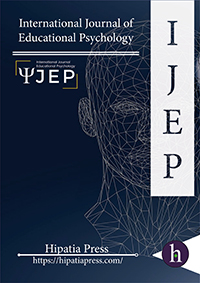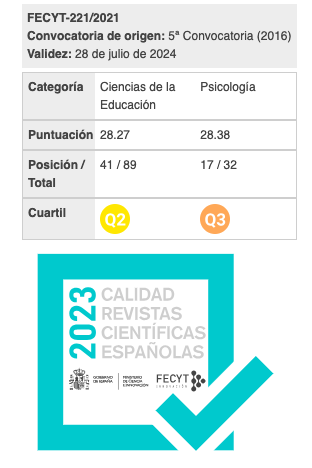Applicant Reactions to a Situational Judgment Test used for Selection into Initial Teacher Training
Keywords:
Downloads
Abstract
We considered applicants’ perceptions of the use of a pilot situational judgment test (SJT) designed for selection into primary and secondary teacher training programs in the UK. Quantitative and qualitative data were collected from 304 applicants (73% female) to two postgraduate (PGCE) training programs in the 2013-2014 application cycle. Participants were asked to provide feedback on the content of the SJTs and on the appropriateness of the tests for selection into teacher training. Results from the rating scales showed that most of the applicants (76.7%) found the content and format of the pilot selection tool favourable. Results from open-ended questions suggested that applicants were aware of issues of procedural justice and fairness in selection for teacher training, with a recommendation that separate selection tests should be created for primary and secondary applicants.Downloads
References
Allen, J., Gregory, A., Mikami, A., Lun, J., Hamre, B., & Pianta, R. (2013).
Google Scholar CrossrefObservations of effective teacher-student interactions in secondary school classrooms: Predicting student achievement with the Classroom Assessment Scoring System—Secondary. School Psychology Review, 42, 76-98. Retrieved from http://www.nasponline.org/publications
Google Scholar CrossrefAtteberry, A., Loeb, S., & Wyckoff, J. (2013). Do first impressions matter? Improvement in early career teacher effectiveness. Calder Working Paper No. 90. Washington DC: American Institutes for Research. Retrieved from http://www.caldercenter.org/publications/calder-working-paper-90.cfm
Google Scholar CrossrefBarber, M. & Mourshed, M. (2007). How the world's best performing school systems come out on top. London: McKinsey & Company.
Google Scholar CrossrefBarr, A. (1952). The measurement of teacher characteristics and prediction of teaching efficiency. Review of Educational Research, 22, 169-174. Retrieved from http://www.jstor.org/stable/1168563
Google Scholar CrossrefBeltman, S., Mansfield, C., & Price, A. (2011). Thriving not just surviving: A review
Google Scholar Crossrefof research on teacher resilience. Educational Research Review, 6, 185-207. http://dx.doi.org/10.1016/j.edurev.2011.09.001
Google Scholar CrossrefBerliner, D. C. (2006). Educational psychology: Searching for essence throughout a century of influence. In P. Alexander and P. Winne (Eds.), Handbook of educational psychology: 2nd edition, (pp. 3-27). Mahway, NJ: Lawrence Erlbaum Associates.
Google Scholar CrossrefCommonwealth of Australia (2014). Teacher Education Ministerial Advisory
Google Scholar CrossrefGroup [Issues Paper]. Australian Government, Department of Education. Retrieved from http://studentsfirst.gov.au/teacher-education-ministerial-advisory-grouphttp://studentsfirst.gov.au/teacher-education-ministerial-advisory-grouphttp://studentsfirst.gov.au/teacher-education-ministerial-advisory-group
Google Scholar CrossrefDarling-Hammond, L. & Youngs, P. (2002). Defining “highly qualified teachers:” What does “scientifically-based research” actually tell us? Educational Researcher, 31, 13-25. http://www.jstor.org/stable/3594491
Google Scholar CrossrefDonaldson, G. (2011). Teaching Scotland’s future. Report of a review of teacher education in Scotland. The Scottish Government, Edinburgh, UK. Retrieved from http://www.scotland.gov.uk/Publications/2011/01/13092132/0
Google Scholar CrossrefElliott, J. G., Stemler, S. E., Sternberg, R. J. Grigorenko, E. L., & Hoffman, N. (2011). The socially skilled teacher and the development of tacit knowledge. British Educational Research Journal, 37, 83-103. doi: 10.1080/01411920903420016
Google Scholar CrossrefGilliland, S. W. (1993). The perceived fairness of selection systems: An
Google Scholar Crossreforganizational justice perspective. Academy of Management Review, 18, 94-
Google Scholar CrossrefRetrieved from http://www.jstor.org/stable/258595
Google Scholar CrossrefGrigorenko, E. L., Sternberg, R. J., & Strauss, S. (2006). Practical intelligence and elementary-school teacher effectiveness in the United States and Israel: Measuring the predictive power of tacit knowledge. Thinking Skills and Creativity, 1, 14-33. doi: 10.1016/j.tsc.2005.03.001
Google Scholar CrossrefHaines, E. L., & Sumner, K. E. (2013). Digging deeper or piling it higher?
Google Scholar CrossrefImplicit measurement in organizational behavior and human resource management. Human Resource Management Review, 23, 229-241. http://dx.doi.org/10.1016/j.hrmr.2012.12.004
Google Scholar CrossrefHanushek, E. A., & Rivkin, S. G. (2012). The distribution of teacher quality and implications for policy. Annual Review of Economics, 4, 131-157. doi:10.1146/annurev-economics-080511-111001
Google Scholar CrossrefHausknecht, J. P., Day, D. V., & Thomas, S. C. (2004). Applicants reactions to
Google Scholar Crossrefselection procedures: An updated model and meta-analyses. Personnel Psychology, 57, 639-683. doi: 10.1111/j.1744-6570.2004.00003.x
Google Scholar CrossrefHobson, A. J., Ashby, P., McIntyre, J., & Malderez, A. (2010). International
Google Scholar Crossrefapproaches to teacher selection and recruitment. OECD Education Working Papers No. 47. OECD Publishing. http://dx.doi.org/10.1787/5kmbphhh6qmx-en
Google Scholar CrossrefHindman, J., & Stronge, J. (2009). The $2 million decision: Teacher selection and principals’ interviewing practice. Educational Research Service Spectrum, 27, 1-10. Retrieved from https://www.strongeandassociates.com/articles.html
Google Scholar CrossrefHouse of Commons Education Committee (2012). Great teachers: attracting, training and retaining the best: Government Response to the Committee’s Ninth Report of Session 2010-2012. London: House of Commons
Google Scholar CrossrefKlassen, R. M., Perry, N. E., & Frenzel, A. (2012). Teachers’ relatedness with students: An underemphasized aspect of teachers’ basic psychological needs. Journal of Educational Psychology, 104, 150-165.
Google Scholar CrossrefKlassen, R. M., & Tze, V. M. C. (2013). Teachers’ self-efficacy, personality, and teaching effectiveness: A meta-analysis. Manuscript in revision.
Google Scholar CrossrefLievens, F., Peeters, H., & Schollaert, E. (2008). Situational judgment tests: a review of recent research. Personnel Review, 37, 426-441.
Google Scholar CrossrefLievens, F., & Sackett, P. R., (2012). The validity of interpersonal skills assessment
Google Scholar Crossrefvia situational judgment tests of predicting academic success and job performance. Journal of Applied Psychology, 92, 460-468. doi: 10.1037/a0025741
Google Scholar CrossrefMarzano, Frontier, & Livingston, (2011). Effective supervision: Supporting the art
Google Scholar Crossrefand science of teaching. Alexandria, VA: ASCD Publications. Retrieved from http://www.ascd.org/publications/books/110019.aspx
Google Scholar CrossrefMetzger, S. A., & Wu, M-J. (2008). Commercial teacher selection instruments: The validity of selecting teachers through beliefs, attitudes, and values. Review of Educational Research, 78, 921-940.
Google Scholar CrossrefMotowidlo, S. J., & Beier, M. E. (2010). Differentiating specific job knowledge from implicit trait policies in procedural knowledge measured by a situational judgment test. Journal of Applied Psychology, 95, 321-333.
Google Scholar CrossrefMotowildlo, S. J., Hooper, A. C., & Jackson, H. L. (2006). A theoretical basis for situational judgment tests. In J. A. Weekley & R. E. Ployhart (Eds.), Situational judgment tests: Theory, measurement and application (pp. 57-81). Mahwah, NJ: Lawrence Erlbaum Associates.
Google Scholar CrossrefOECD: Organisation for Economic Cooperation and Development (2005). Teachers matter: Attracting, developing and retaining effective teachers. Paris, France: OECD Publications. Retrieved from http://www.oecd.org/education/school/attractingdevelopingandretainingeffectiveteachers-finalreportteachersmatter.htm
Google Scholar CrossrefPatterson, F., Zibarras, L., Carr, V., Irish, B., & Gregory, S. (2011). Evaluating candidate reactions to selection practices using organizational justice theory. Medical Education, 45, 289-297. doi:10.1111/j.1365-2923.2010.03808.x
Google Scholar CrossrefPatterson, F., Ashworth, V., Kerrin, M, & O’Neill, P. (2013). Letters to the Editor: Situational judgment tests represent a measurement method and can be designed to minimize coaching. Medical Education, 47, 219-221. doi: 10.1111/medu.12100
Google Scholar CrossrefPatterson, F., Ashworth, V., Mehra, S. & Falcon, H. (2012). Could situational
Google Scholar Crossrefjudgment tests be used for selection into dental foundation training? British Dental Journal, 213, 23-26. doi: 10.1038/sj.bdj.2012.560
Google Scholar CrossrefPatterson, F., Lievens, F., Kerrin, M., Munro, N., & Irish, B. (2013). The predictive validity of selection for entry into postgraduate training in general practice: evidence from three longitudinal studies. British Journal of General Practice, November, e734-e741. doi: 10.3399/bjgp13X674413
Google Scholar CrossrefPatterson, F., Tavabie, A., Denney, M, Kerrin, M., Ashworth, V., Koczwara, A., & MacLeod, S. (2013). A new competency model for general practice. British Journal of General Practice, May, e331-e338. doi:10.3399/bjgp13X667196
Google Scholar CrossrefRammstedt, B., & John, O. P. (2007). Measuring personality in one minute or less: A
Google Scholar Crossref-item short version of the Big Five Inventory in English and German. Journal of Research in Personality, 41, 203-212. doi:10.1016/j.jrp.2006.02.001
Google Scholar CrossrefRutledge, S. A., Harris, D. N., Thompson, C. T., & Ingle, W. K. (2008). Certify,
Google Scholar Crossrefblink, hire: An examination of the process and tools of teacher screening and selection. Leadership and Policy in Schools, 7, 237-263. 10.1080/15700760701822132
Google Scholar CrossrefRyan, A. M., & Ployhart, R. E. (2014). A century of selection. Annual Review of Psychology, 65, 20.1-20.25. doi: 10.1146/annurev-psych-010213-115134
Google Scholar CrossrefSchultheiss, O. C., & Köllner, M. G. (2014). Implicit motives, affect, and the development of competencies. In R. Pekrun & L. Linnenbrink-Garcia (Eds.), International handbook of emotions in education (pp. 73-95). New York: Taylor & Francis.
Google Scholar CrossrefShultz, M. M., & Zedeck, S. (2012). Admission to Law School: New measures. Educational Psychologist, 47, 51-65. doi: 10.1080/00461520.2011.610679
Google Scholar CrossrefStaiger, D. O., & Rockoff, J. E. (2010). Searching for effective teachers with
Google Scholar Crossrefimperfect information. Journal of Economic Perspectives, 24, 97-118. doi: 10.1257/jep.24.3.97
Google Scholar CrossrefStemler, S. E., Elliot, J. G., Grigorenko, E. L., & Sternberg, R. J. (2006). There’s
Google Scholar Crossrefmore to teaching than instruction: Seven strategies for dealing with the practical side of teaching. Educational Studies, 32, 101-118. doi: 10.1080/03055690500416074
Google Scholar CrossrefUCAS: Universities and Colleges Admissions Service (2014, April). UCAS Teacher
Google Scholar CrossrefTraining Applications [Report A and B]. UTT Monthly Statistics: Applications. Gloucestershire, UK: UCAS. Retrieved from http://www.ucas.com/ucas-teacher-training
Google Scholar CrossrefWalker, H. J., Bauer, T. N., Cole, M. S., Bernerth, J. B., Feild, H. S., & Short, J. C. (2013). Is this how I will be treated? Reducing uncertainty through recruitment interactions. Academy of Management Journal, 56, 1325-1347. doi: doi:10.5465/amj.2011.0196
Google Scholar CrossrefWhetzel, D. L., & McDaniel, M. A. (2009). Situational judgment tests: An overview of current research. Human Resource Management Review, 19, 188-202. doi:10.1016/j.hrmr.2009.03.007
Google Scholar CrossrefWright, S. P., Horn, S. P., & Sanders, W. L. (1997). Teacher and classroom context effects on student achievement: Implications for teacher evaluation. Journal of Personnel Evaluation in Education, 11, 57-67. doi:10.1023/A:1007999204543
Google Scholar CrossrefYoung, I. P. & Delli, D. A. (2002). The validity of the Teacher Perceiver Interview for predicting performance of classroom teachers. Education Administration Quarterly, 38, 586-612. doi: 10.1177/0013161X02239640
Google Scholar CrossrefDownloads
Published
Almetric
Dimensions
How to Cite
Issue
Section
License
All articles are published under Creative Commons copyright (CC BY). Authors hold the copyright and retain publishing rights without restrictions, but authors allow anyone to download, reuse, reprint, modify, distribute, and/or copy articles as the original source is cited.
















